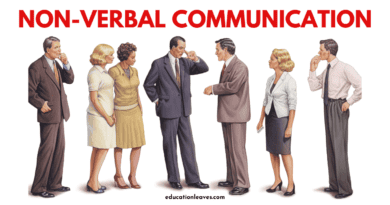Group Behavior and Communication- EDUCATIONLEAVES
In this exploration, we’ll delve into the fascinating world of group behavior and communication. We’ll begin by unraveling the fundamental principles that govern how individuals interact within a group. We’ll examine the influence of social norms, roles, and hierarchies, and explore how these factors impact decision-making, conflict resolution, and overall group performance.
Think of a beehive, a buzzing microcosm of coordinated activity. Each bee plays a specific role, from queen to worker, and their communication through pheromones keeps the hive functioning as a single organism. Similarly, human groups establish norms and roles, often unspoken rules of conduct that guide behavior and maintain order. These norms can be as simple as taking turns while speaking or as complex as dress codes in professional settings.
Roles, on the other hand, assign specific responsibilities and expectations to individual members. A team leader, for instance, takes charge of decision-making, while others may contribute specialized skills or knowledge. Hierarchies further influence group dynamics, with leaders often wielding greater power and influence. Understanding these dynamics is crucial for anyone navigating the complexities of social interactions, whether in the workplace, family, or even online communities.

What you are going to learn?
Communication Channels in Group Dynamics
Now, let’s shift our focus to the language of groups: the diverse communication channels that facilitate interaction and coordination. Imagine a concert hall. Orchestra members rely on a combination of written scores, visual cues from the conductor, and unspoken understandings of timing and dynamics to produce a harmonious melody. Similarly, groups utilize a multifaceted communication system to achieve their goals.
Verbal Communication:
The most obvious channel, spoken words, allow for explicit information exchange and discussion. Leaders guide, members share ideas, and decisions are made through verbal communication. However, its effectiveness hinges on factors like clarity, active listening, and respect for diverse perspectives. Imagine a heated debate where participants talk over each other or dismiss opposing viewpoints. Such communication breakdown can hinder progress and derail group cohesion.
Nonverbal Communication:
Beyond words, a complex web of nonverbal cues shapes group dynamics. Facial expressions, body language, posture, and even vocal tone convey volumes of information. A warm smile can foster trust, while crossed arms might indicate resistance. Leaders often adeptly utilize nonverbal cues to gauge engagement, maintain order, and inspire their team. For example, a confident stride and direct eye contact can project authority and motivate others.
Implicit Communication:
Beyond deliberate expressions, unspoken rules and shared understandings guide group behavior. These implicit assumptions, rooted in shared experiences or cultural norms, dictate communication patterns and decision-making processes. Imagine a group of close friends planning a surprise party. They might rely on subtle cues and inside jokes without explicitly discussing details, demonstrating the power of implicit communication.
Power Dynamics and Communication:
Communication within groups is rarely an equal-footing exchange. Power dynamics, based on factors like status, expertise, or personality, influence how information flows and decisions are made. Leaders often have greater access to communication channels and their words carry more weight. However, effective groups strive to create open communication channels where all members feel empowered to share ideas and concerns.
Diverse Groups and Communication Nuances

Now, let’s embark on a journey through the diverse landscape of group types, examining how their structures and goals shape their communication styles and challenges.
Formal Teams:
Picture a corporate boardroom, a scientific research team, or a sports team. These are formal groups, characterized by defined structures, roles, and objectives. Communication in such groups often follows an established hierarchy, with leaders utilizing formalized channels like meetings, reports, and email to disseminate information and guide decision-making. Clarity, conciseness, and adherence to protocol are paramount for effective communication within these groups.
Informal Networks:
Beyond the structured world of formal teams lie informal networks – the buzzing hives of social circles, friendship groups, and online communities. Communication in these groups flourishes through spontaneous conversations, shared anecdotes, and inside jokes. Emotion, empathy, and non-verbal cues play a more prominent role, fostering a sense of connection and belonging. However, navigating gossip, misunderstandings, and conflicting opinions can be a delicate dance in these fluid, less-structured groups.
Cultural Melting Pots:
The world is a tapestry of diverse cultures, each with its own unique communication styles and norms. When individuals from different cultural backgrounds come together in a group, effective communication becomes even more crucial. Understanding differences in verbal and nonverbal cues, respecting varying levels of formality, and acknowledging diverse perspectives are key to overcoming cultural barriers and fostering collaboration.
Virtual Landscapes:
With the rise of technology, our social interactions have transcended physical boundaries. Virtual teams, online communities, and social media groups have become commonplace. Communication in these digital spaces relies heavily on written words, emojis, and online etiquette. While offering flexibility and accessibility, virtual communication presents challenges like misinterpreting tone, navigating information overload, and overcoming the lack of non-verbal cues.
By recognizing the varied nature of groups and their unique communication nuances, we can become more adept at adapting our communication style, fostering inclusivity, and navigating the challenges that arise.
Strategies for Effective Communication in Diverse Groups
We’ve traversed the landscape of group behavior, explored the communication channels that bind them, and navigated the diverse types of groups populating our world. Now, we arrive at the crucial crossroads: how do we cultivate effective communication within these dynamic entities? Here are some key strategies to bridge the gaps and unlock the full potential of group collaboration:
Active Listening:
This goes beyond simply hearing words. It involves paying close attention, refraining from interrupting, and seeking to understand the speaker’s intent and emotions. By employing active listening, we can foster a sense of trust and respect, encouraging others to share their perspectives freely.
Empathy and Cultural Sensitivity:
Recognizing and respecting diverse viewpoints is vital. Stepping into others’ shoes allows us to appreciate their lived experiences and interpret their communication through their cultural lens. This fosters inclusivity and prevents misunderstandings from festering.
Clarity and Conciseness:
Whether formal or informal, effective communication hinges on clear, concise expression. Articulate your thoughts and ideas efficiently, avoiding jargon and ambiguity. Consider your audience and tailor your message accordingly, ensuring everyone grasps the essence of your communication.
Open and Honest Communication:
Fostering an environment where diverse opinions are welcomed and respected is crucial. Encourage constructive criticism and open dialogue, allowing for healthy debate and exploration of alternative perspectives. This transparency builds trust and paves the way for innovative solutions.
Nonverbal Communication Savvy:
Remember, words are not the only way we communicate. Be mindful of your body language, facial expressions, and tone of voice. These nonverbal cues can significantly impact the interpretation of your message. Adjust your nonverbal communication to align with your intended meaning and create a positive atmosphere.
Technology as a Bridge:
Embrace the power of technology to enhance communication within diverse groups. Utilize video conferencing platforms to bridge physical gaps, employ collaborative online tools to facilitate project management, and leverage instant messaging for quick updates and discussions. However, remember to strike a balance between virtual and in-person interaction, fostering genuine human connection amidst technological advancements.
By consciously implementing these strategies, we can transform group communication from a chaotic cacophony into a symphony of collaboration. We can bridge cultural divides, overcome communication barriers, and unlock the collective potential of diverse groups to achieve remarkable results. Remember, effective communication is not a destination, but a continuous journey of exploration, adaptation, and refinement. Embrace the challenges, celebrate the successes, and keep forging stronger, more fulfilling connections within the fascinating world of group dynamics.
A Final Look at Group Behavior and Communication
As we conclude our exploration of group behavior and communication, a captivating picture emerges. We’ve glimpsed the intricate dance of individuals within groups, the intricate tapestry of communication channels they employ, and the diverse landscapes of group types that populate our world. From the structured world of formal teams to the vibrant buzz of online communities, each group pulsates with a unique language and set of challenges.
The key takeaway isn’t a static formula, but an invitation to a continuous dance of understanding and adaptation. Effective communication within groups isn’t a destination, but a journey; a constant interplay of active listening, empathy, clarity, and openness. By embracing the differences in styles, norms, and cultural nuances, we can weave a rich tapestry of collaboration, unlocking the collective potential of diverse individuals.
Remember, the power of groups lies not just in individual brilliance, but in the harmonious convergence of diverse perspectives and effective communication. As we navigate the intricate web of group dynamics, let this be our guiding principle: communicate with purpose, foster inclusivity, and embrace the magic of shared understanding. Every conversation, every interaction, contributes to the symphony of the collective mind, shaping the world around us, one meaningful connection at a time.
So, step into the vibrant world of groups, equipped with these insights and strategies. Become a catalyst for effective communication, a bridge between diverse viewpoints, and a champion of collaboration. By nurturing the art of communication within groups, we unlock the potential for innovation, progress, and a more connected, more harmonious world. The stage is set, the lights are on, and it’s your turn to join the dance. Together, let’s rewrite the story of group dynamics, one eloquent conversation at a time.




